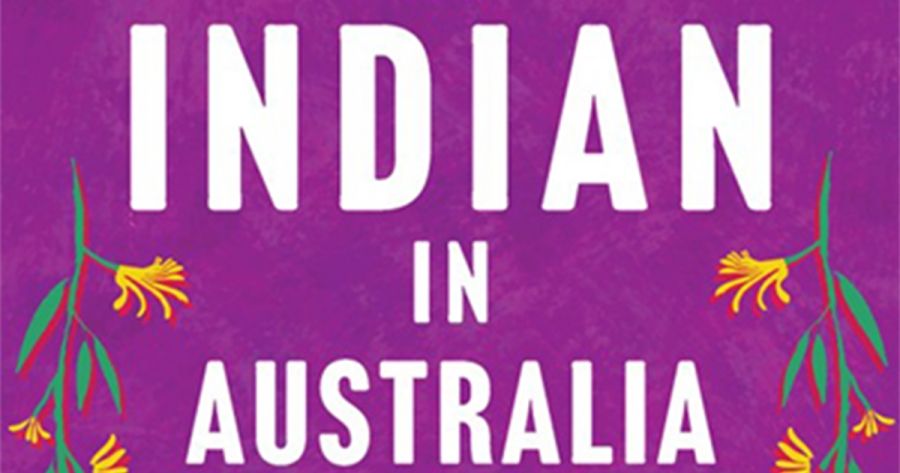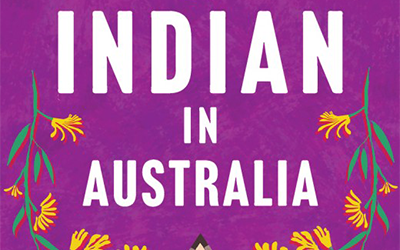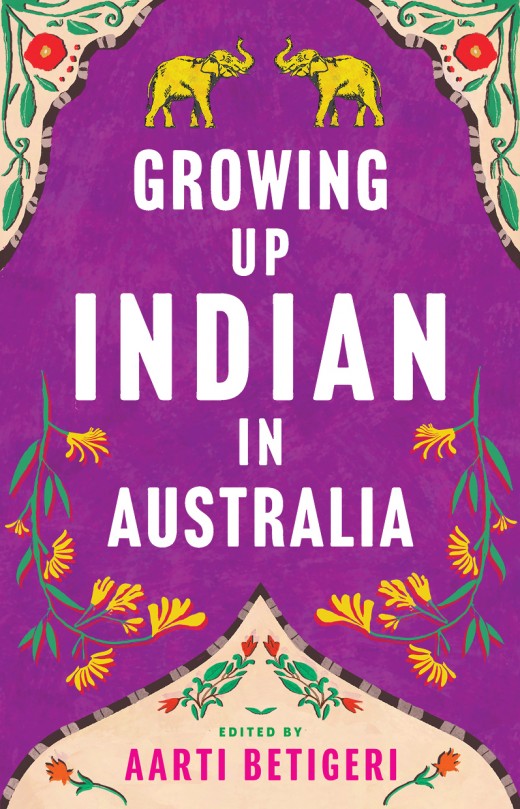
- Free Article: No
- Contents Category: India
- Review Article: Yes
- Article Title: Toshakhana
- Article Subtitle: Indian paths to self-discovery
- Online Only: No
- Custom Highlight Text:
Don’t judge a book by its cover? There is no problem with this book. The cover and artist’s note, declaring inspiration from such diverse art forms as traditional Indian miniature painting, Indian matchbox design, and a ‘harmonious blend of Indian and Australian flora’, encapsulate the intertwining narratives and cultural crossovers of the stories within.
- Featured Image (400px * 250px):

- Alt Tag (Featured Image): Claudia Hyles reviews ‘Growing up Indian in Australia’ edited by Aarti Betigeri
- Book 1 Title: Growing up Indian in Australia
- Book 1 Biblio: Black Inc., $32.99 pb, 263 pp
- Book 1 Cover Small (400 x 600):

- Book 1 Cover (800 x 1200):

Betigeri writes, ‘We used to call ourselves ABCDs, Australian-Born Confused Desis.’ Desi means a person of South Asian descent but also, pure. Pure confusion? It is a recognised condition described by most writers, starting at school, often lasting into adulthood, perhaps forever. Children have to learn how to navigate two paths, home life and outside.
The diversity of the Indian subcontinent means that, while there are numerous common experiences, there are also many differences. The writers, ranging in age from sixteen to the mid-fifties, settled with their families all over Australia, in big urban centres, in suburbs ranging from the sublime (Sylvania Waters) to the ridiculous (Blacktown), and in smaller country towns. They are female and male, gay, straight, and trans, from different castes and backgrounds: Anglo-Indian, Sikh, Hindu, Muslim, Christian, Jewish, atheist, and lapsed. Some were born in Australia, others arrived as children from India or Indian communities in Fiji, Malaysia, and East Africa, adding further regional divergence.
The story of migration lies at the heart of the book, and with it the search for coherence, connection, identity, approval from new communities, and, importantly, self-acceptance. ‘My path to self-discovery’ could be a subtitle. The Indian-born population is now Australia’s second-largest migrant community – 976,000 at last count and growing constantly. The numbers doubled between 2011 and 2021. Australia proclaims multicultural diversity as a strength, promoting societal tolerance, but instances of racial profiling, verbal abuse, and worse still occur.
Several stories allude to the suffocating atmosphere of Indian community groups, with elders failing to cope with the growing Australianisation of the younger generation. Faith group gatherings, once the week’s highlight for children, can become tedious for moody teenagers flexing their muscles.
Today, many Indian migrants come as tertiary students without having to navigate the minefield of schoolyard, classroom, and bullies. Those experiences might, with hindsight, have been character-building, but they were an ordeal. Some new wave arrivals feel that the experience of childhood and adolescence, with the family immersion, is an advantage. The anthology probably reinforces this, but achieving such an edge in the quest for belonging usually involves pain. Being the only brown child, or one of few, in a school full of whites (or pinko-greys, to quote E.M. Forster), can be daunting. Some find their tribe at university, others rediscover yoga and Indian dance in a white milieu.
School is a major theme; a second, food, features in more than half the stories, some at nostalgic length – special festival dishes no longer being made by some; the evocative smell and crackle of curry leaves frying; fasting; philosophy on the nature of curry; learning how to cook ‘by feel’ as a metaphor for life; children yearning for sandwiches or a meat pie for school lunch instead of leftover sambar, rice, and pickles, or idli and chutney, its distinctive aroma inviting ridicule from white sandwich-eaters.
Clothing, like food, is connected to what is familiar and traditional. The need to conform and look like everyone else is a common condition, and not just for children. It is unsurprising that a mother’s colourful sari, highly visible among other parents, caused acute embarrassment for her offspring at a conservative private school. For that child, being dressed in kurta pyjamas and a Congress cap for a special multicultural day years before was a similar torture, reminding him that he didn’t belong.
Some writers grew up in affluent homes with professional parents, often doctors. Other families had to count every cent in order to achieve the goal of a better life that brought them to Australia. A touching memory about clothing was the second-hand coat bought by one father to keep warm while waiting for his commuter trains. His daughter later discovered it was a cast-off school-issue lab coat, too light for winter chills.
Discipline at home was generally more restrictive than for Australian children. Sleepovers, discos, and parties were often forbidden. Adolescence brought a certain level of understanding and confidence, but also defiance – wearing clothing deemed unsuitable, binge-drinking, clubbing, the strange new beach culture, or even the removal of superfluous hair. Many regretted losing connections with grandparents, particularly when they no longer shared a language. Family values and dutifulness to parents remain strong, and stories reveal parents accepting all manner of shocks from their children, perhaps a form of growing up for them too.
One contributor quotes the first line of L.P. Hartley’s novel The Go-Between: ‘The past is a foreign country: they do things differently there.’ India, with its rich and pervasive culture, is famous for subtle absorption and transformation of foreign elements, and diasporic Indians are chameleons. It is a continuing metamorphosis for those endowed with the good fortune to be citizens of two countries.
Often amusing, sometimes sad, the anthology is a toshakhana, a treasury of delights for readers of all shades.


Comments powered by CComment